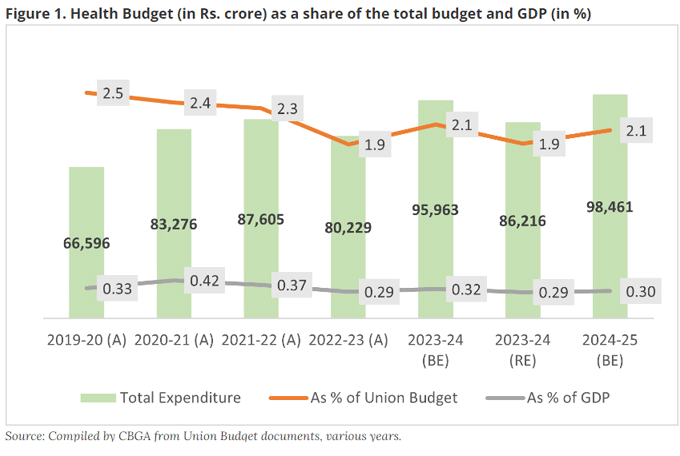Headlines of The Day
Budgetary allocation for health stands at ₹98,461 crore, an increase of 2.6%

The National Health Policy, 2017 set a target of increasing India’s health expenditure to 2.5% of its gross domestic product by 2025. In this post, Sayamsiddha decodes the recently presented Interim Budget, with a spotlight on outlays for health programmes. In her view, the government should complement their current focus on insurance models and private sector role with adequate and effective public provisioning of healthcare.
The allocation for health in the recently presented Interim Union Budget for 2024-25 was of particular importance, as we are approaching the deadline set by the National Health Policy (NHP), 2017 to achieve the target of increasing India’s health expenditure to 2.5% its GDP (gross domestic product) by 2025. With the Covid-19 pandemic reaffirming the need to focus on universal healthcare, the expectation from the Interim Budget was that it would bridge the gap in public financing and address the persistent challenges in the health sector related to infrastructure, human resources, and high out-of-pocket expenditure, among others.
Decoding Interim Budget 2024-25 for health
According to the Centre for Budget and Governance Accountability’s (CBGA) analysis of the Union Budget, the overall allocation in 2024-25 for the health sector stood at Rs. 98,461 crore, which is a marginal increase of 2.6% from the previous budget estimates (BE) and a 14.2% increase from the revised estimates (RE). However, despite the enhanced allocations, the sector’s share in the total Interim Budget and as percentage of GDP has declined over the years (Figure 1). The 143rd Report of the Parliamentary Standing Committee notes that such trends of budgetary allocations do not align with the targets set by the NHP (2017) and highlights the need to assign adequate priority to the health sector.

It must be noted that while the central government plays a pivotal role in formulating health policies, coordinating national health programmes, and providing financial support to states, the responsibility of healthcare delivery lies with the state governments. However, our analysis in this post will be limited to the scope of the Interim Budget 2024-25, as the central government makes pivotal foundations to enable and facilitate the states to fulfill their responsibilities.
This year, in her budget speech, Finance Minister Nirmala Sitharaman stated that the central government encourages vaccination for girls between the ages 9 to 14 for the prevention of cervical cancer and leveraging the U-WIN platform to manage and intensify immunisation, and plans to build more medical colleges using the existing medical and hospital infrastructure. Another major announcement was related to extending the coverage under the insurance scheme Ayushman Bharat to Accredited Social Health Activitist (ASHA) and Anganwadi workers and Helpers (AWWs and AWHs) who otherwise remain outside the ambit of social security given their status as volunteers instead of workers. While these announcements are positive, they are not reflected in the budgetary allocations.
Where are we now in terms of universal healthcare?
According to Rural Health Statistics (RHS) of 2021-22, in rural areas, there is a 25% shortfall in Sub Centres (SCs), 31% shortfall in Primary Health Centres (PHCs), and 36% shortfall in Community Health Centres (CHCs). Similarly, in the case of urban areas, the shortfall in PHCs was reported to be 39.7%. In tribal areas, there is 7.6% deficit in SCs, 30.7% in PHCs and 23.8% in CHCs. In order to address these shortfalls and strengthen the health infrastructure in both rural and urban India, the 15th Finance Commission recommended the provision of Rs. 70,051 crore in health grants from the union to the states for the period from 2021-22 to 2025-26. However, an analysis of the last four years reveals that only Rs. 25,564.87 crore, or 36.5% of the total recommended provision, has been released so far.
Among the major schemes for health announced in the Interim Budget 2024-25, a mixed trend can be observed. Under the Department of Pharmaceuticals, schemes such as Jan Aushadhi, which aims to provide quality generic medicines at affordable prices to the masses, and the Production Linked Incentive (PLI) Scheme, which seeks to promote India’s manufacturing capabilities in the pharmaceutical sector, were given impetus – with an increase in allocation by 147% and 79% respectively over previous year’s budget estimates. However, schemes meant for infrastructure development, such as Pradhan Mantri Swasthya Suraksha Yojana (PMSSY), which envisages creation of tertiary healthcare capacity, and Pradhan Mantri Ayushman Bharat Health Infrastructure Mission (PMABHIM), which focuses on developing primary, secondary and tertiary health infrastructure, reported a decline in the current Budget compared to 2023-24 estimates (BE) by 29% and 7%, respectively. It is important to address this trend with a proactive approach, especially considering the current state of health infrastructure in India.
The budgetary trends for major schemes such as National Health Mission reported a 3.7% increase in allocation compared to the previous BE, while schemes such as National Tele Mental Health Programme and National Digital Health Mission experienced a decline of 25% and 27%, respectively, as compared to previous BE. Along with such trends of stagnation or decline in provisioning for major schemes, the out-of-pocket expenditure for health continues to remain high with a declining trend according to Economic Survey, 2022-23. However, as per the National Accounts Statistics (2023), Private Final Consumption Expenditure (PFCE) on health (at constant 2011-12 prices) has increased by 128% between 2011-12 and 2021-22.
Complementing partnership and insurance models with public provisioning
In the current discourse, significant emphasis is being placed on a public-private partnership model or an insurance model for healthcare. A similar trend can be observed in the central government’s policies and budgetary outlays towards strengthening insurance schemes such as Pradhan Mantri Jan Arogya Yojana (which was allocated Rs. 7,500 crore in Interim Budget 2024-25) and the private sector’s role in healthcare. In December 2023 the Ministry of Finance engaged in talks with insurance companies about establishing a regulator for the health sector in efforts to organise, standardise and regulate hospitals under the insurance programme, expedite insurance penetration, and achieve ‘insurance for all’.
However, in order to achieve universal healthcare, efforts must be complimented by adequate and effective public provisioning measures to address the persistent challenges in the health sector. Kuruvilla et al. (2018) recommend a life-course approach to universal healthcare, which encompasses a holistic and long-term policy and investment strategy that promotes better health outcomes for individuals and greater health equity among the population. In order to achieve such outcomes, primary healthcare must be strengthened through equitable provisioning of promotive, preventive, curative, rehabilitative and palliative services (Anju et al. 2018).
Going forward, the central government must focus on developing sustainable, equitable, affordable and accessible health systems by allocating the mandated 2.5% of the GDP towards health and ensure attainment of Sustainable Development Goal (SDG) 3 which resolves to “ensure healthy lives and promote well-being for all at all ages”. After all, ensuring universal healthcare can help achieve both short- and long-term goals related to individual and overall well-being of communities, reduce healthcare costs, establish social equity and ultimately promote economic growth. Ideas for India












